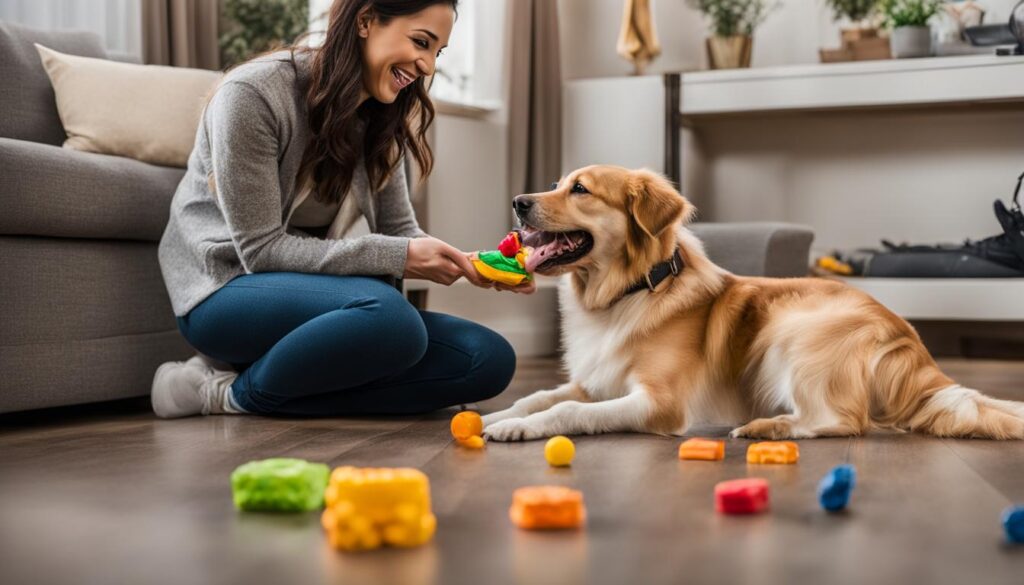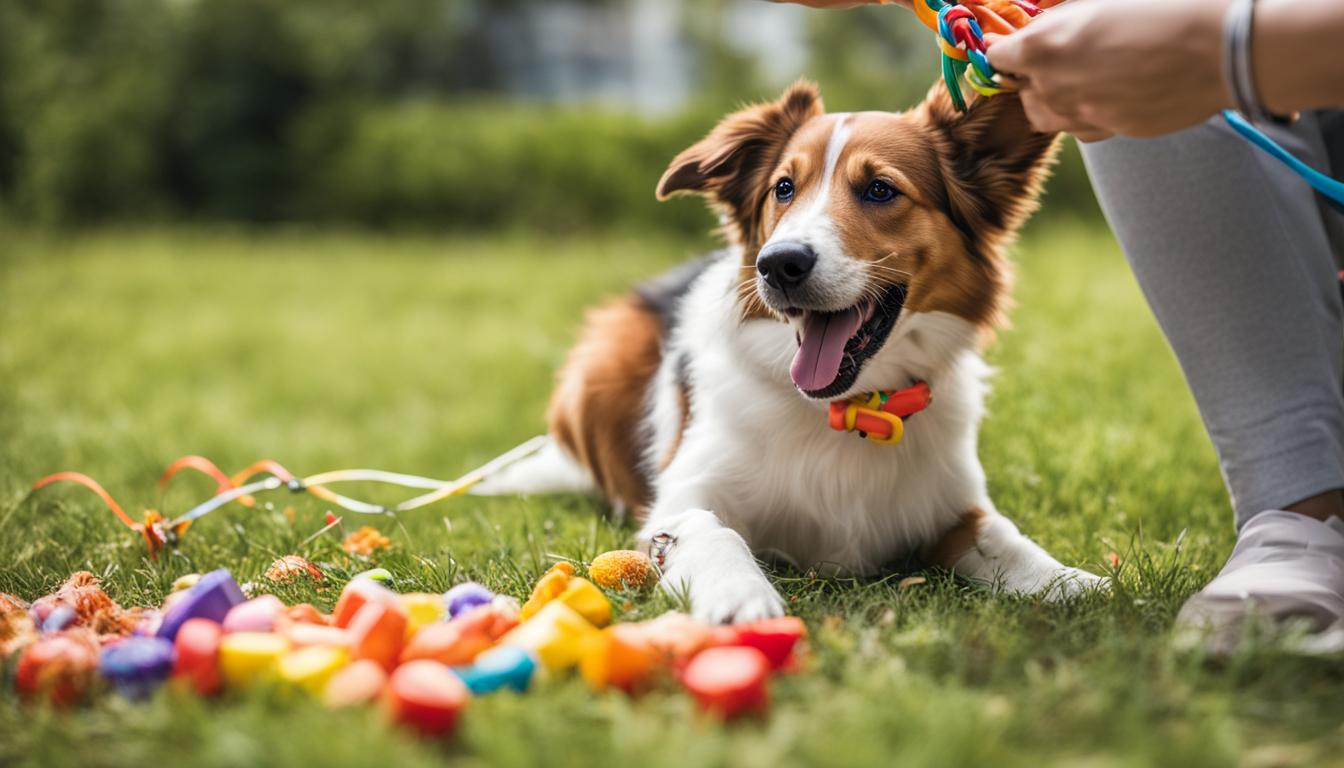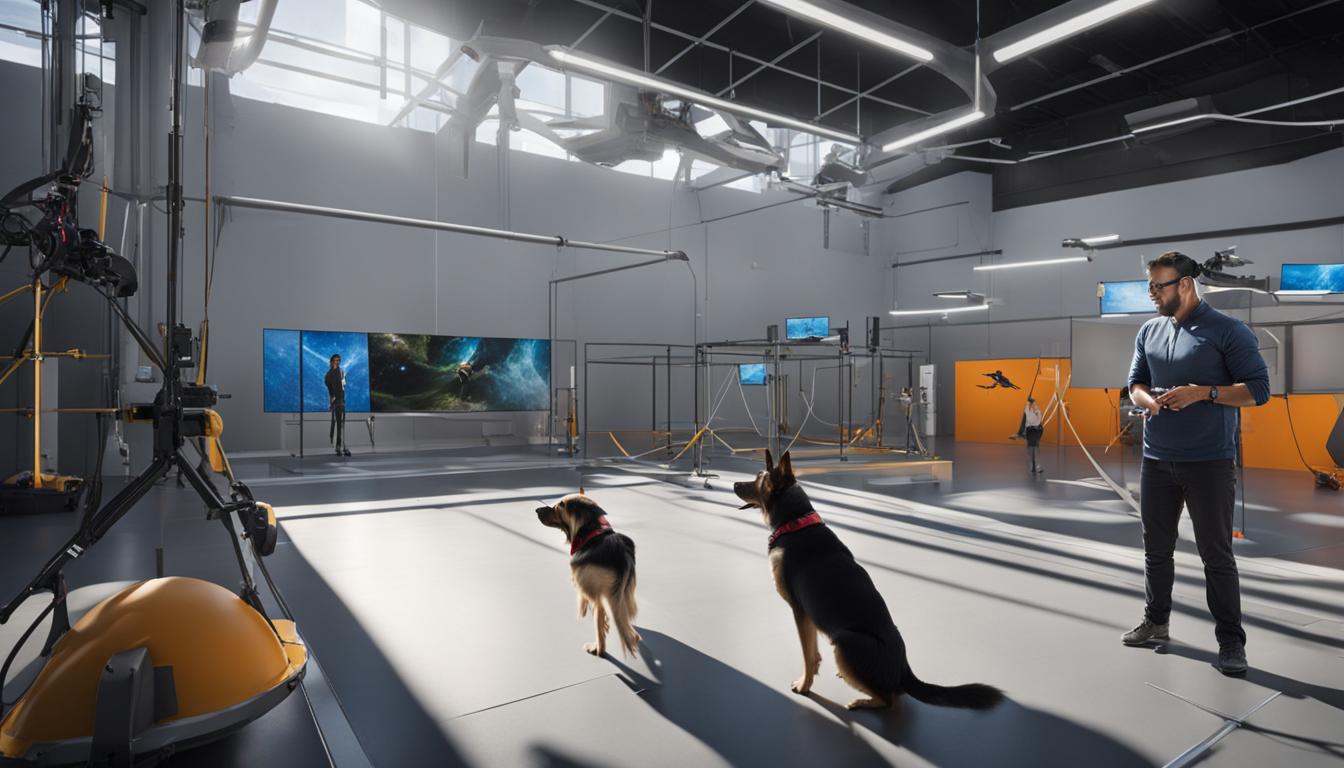Welcome to the world of dog training, where positive reinforcement techniques reign supreme! If you’re looking for effective ways to train your furry friend while building a strong bond, you’ve come to the right place. With the power of rewards, praise, and consistency, you can teach your dog new behaviors and commands while fostering a loving and trusting relationship.
Key Takeaways:
- Positive reinforcement training is a powerful technique for teaching dogs new behaviors and strengthening the bond between dogs and their owners.
- By using rewards, praise, and consistent training sessions, you can effectively train your dog and provide mental stimulation.
- Starting with basic commands, such as sit, stay, come, and heel, sets the foundation for more advanced training.
- Short, fun training sessions help keep dogs engaged and prevent them from becoming overwhelmed.
- Seeking professional help from a certified dog trainer can provide valuable guidance and support when needed.
Getting Started with Basic Commands
Before diving into complex training sessions, it’s important to start with basic commands such as sit, stay, come, and heel. These commands lay the groundwork for more advanced training and help dogs become well-behaved and obedient. According to experts, basic commands should be taught in different situations and environments to ensure that dogs respond to cues regardless of the circumstances.
Using positive reinforcement methods, such as treats or verbal praise, is crucial when teaching your dog basic commands. Rewards and praise serve as motivation for your furry friend to learn and repeat the desired behaviors. By associating these commands with positive experiences, your dog will be more eager to listen and follow your instructions.
Remember, consistency is key when training your dog. Use the same commands and gestures consistently to avoid confusion and reinforce the desired behavior. Breaking down each command into simple steps and rewarding your dog for every small success will make the learning process more enjoyable and effective.
Here is a table summarizing some common basic commands and their importance in dog obedience training:
| Command | Description |
|---|---|
| Sit | Teaches your dog to sit on command and wait for further instructions. |
| Stay | Teaches your dog to remain in a specific position until given the release command. |
| Come | Teaches your dog to come to you when called, improving their recall skills. |
| Heel | Teaches your dog to walk calmly by your side without pulling on the leash. |
By focusing on these basic commands, you’ll establish a solid foundation for your dog’s training journey. Remember to be patient, consistent, and always reward your dog for their progress. With time and practice, your furry friend will become a well-behaved and obedient companion.

The Power of Consistency in Dog Training
Consistency is key when it comes to dog training. By using the same commands and routines every time you train your dog, you can establish a strong foundation for learning and prevent confusion. Dogs learn best through repetition, so consistent training plays a vital role in their understanding and response to commands.
Being consistent means using the same verbal cues and hand signals for each command. For example, if you use the word “sit” to teach your dog to sit, stick to that command and avoid using variations like “sit down” or “take a seat.” Consistency also extends to your tone of voice and body language, which should remain constant during training sessions.
Table: Benefits of Consistent Dog Training
| Benefits | Description |
|---|---|
| 1. Clarity | Consistency helps your dog understand what is expected of them, reducing confusion and frustration. |
| 2. Reliable Response | Consistent training reinforces desired behaviors, resulting in a reliable response from your dog. |
| 3. Improved Focus | Regular and consistent training sessions help improve your dog’s focus and attention span. |
| 4. Strengthened Bond | Consistent training builds trust and strengthens the bond between you and your dog. |
Another aspect of consistency in dog training is maintaining a regular training routine. Dogs thrive on structure and predictability, so scheduling dedicated training sessions at the same time each day can enhance their learning experience. Set aside a specific training area in your home or backyard where distractions are minimized, allowing your dog to focus on the task at hand.
Remember, consistency is not only important during active training sessions but also in everyday interactions with your dog. Reinforce consistent behavior expectations throughout the day, rewarding good behavior and redirecting inappropriate behavior. With time and patience, your dog will develop a clear understanding of their role and become a well-behaved and obedient companion.
Key Takeaways:
- Consistency is crucial in dog training to establish a strong foundation for learning and prevent confusion.
- Use the same commands, cues, tone of voice, and body language consistently during training sessions.
- Maintain a regular training routine to provide structure and predictability for your dog.
- Consistent training helps improve focus, reliability, and strengthens the bond between you and your dog.
Consistency is the key to effective dog training. By maintaining consistent commands, routines, and expectations, you pave the way for a well-behaved and obedient companion. Remember to be patient and persistent, as dogs learn best through repetition. With consistent training, you can build a strong bond with your furry friend and enjoy the rewards of a positive and rewarding training experience.
Short and Fun Training Sessions
Dogs have short attention spans, so keeping training sessions short and engaging is important. According to experts, training sessions should typically last between 5-15 minutes to prevent dogs from becoming overwhelmed. It’s also crucial to end each session on a positive note to keep your dog motivated and eager to learn.
Incorporating fun games into training can make the process more enjoyable for both you and your furry friend. Games like fetch or hide-and-seek can help keep dogs engaged and mentally stimulated during training. Not only do these games provide physical exercise, but they also reinforce obedience and stimulate problem-solving skills.
To demonstrate the effectiveness of short and engaging training sessions, consider the following table:
| Training Session | Duration | Training Activities |
|---|---|---|
| Session 1 | 10 minutes | Basic commands: sit, stay, come |
| Session 2 | 10 minutes | Fun game: fetch with a favorite toy |
| Session 3 | 15 minutes | Advanced command: heel |
As you can see, each training session is kept short to maintain focus and prevent boredom. The incorporation of a fun game in the second session adds excitement and keeps the dog engaged. This approach allows for effective training while also making it an enjoyable experience for both you and your furry friend.
Seeking Professional Help in Dog Training
While positive reinforcement training can be effective for many dog owners, there may come a time when seeking professional help becomes necessary. Professional dog trainers have the knowledge and expertise to address specific behavior issues and provide you with the guidance you need to train your dog effectively. By working with a professional, you can gain valuable insights into your dog’s behavior and receive personalized training plans tailored to your pet’s individual needs.
Professional dog trainers understand the complexities of canine behavior and can help you navigate challenges such as aggression, anxiety, or fear. They can assess your dog’s temperament and develop a customized training program that focuses on positive reinforcement techniques. With their guidance, you can learn how to effectively communicate with your dog and address any behavioral issues that may be hindering your training progress.
Working with a dog trainer also provides an opportunity for socialization. Trainers often conduct group classes where dogs can interact with other pets, helping them develop better social skills and become more comfortable in different environments. Additionally, trainers can offer support and encouragement throughout the training process, giving you the confidence and motivation to continue your dog’s training journey.
When seeking a professional dog trainer, it’s important to look for someone who is certified and experienced. Ask for recommendations from friends, family, or your veterinarian, and don’t hesitate to interview potential trainers to ensure they align with your training philosophy and goals. Remember, seeking professional help is a sign of dedication to your pet’s well-being and can greatly enhance your training outcomes.

Benefits of Working with a Dog Trainer:
- Expert knowledge and guidance for addressing behavior issues
- Personalized training plans tailored to your dog’s needs
- Opportunity for socialization and interaction with other dogs
- Ongoing support and encouragement throughout the training process
- Enhanced training outcomes and a stronger bond with your dog
“Working with a professional dog trainer can provide the expertise and support you need to overcome any training challenges and achieve your desired results.”
The Benefits of Positive Reinforcement Training
Positive reinforcement training offers numerous benefits for both dogs and their owners. By utilizing positive training techniques, you can create a more harmonious and enjoyable relationship with your furry friend. Here are some of the key benefits:
1. Effective Training Techniques
Positive reinforcement training methods have been proven to be highly effective in teaching dogs new behaviors and commands. By using rewards, praise, and play, you can motivate your dog to learn and repeat desired behaviors. This approach focuses on rewarding good behavior rather than punishing undesirable actions, leading to a happier and more obedient dog.
2. Strengthening the Bond
Positive reinforcement training not only helps dogs learn, but it also strengthens the bond between dogs and their owners. By creating a positive and rewarding learning experience, you build trust and enhance the emotional connection with your dog. This can result in a deeper and more fulfilling relationship, based on mutual respect and understanding.
3. Promoting Mental Stimulation
Positive reinforcement training sessions can provide mental stimulation for your dog. By incorporating fun games and interactive activities into training, you keep your dog engaged and mentally challenged. This helps prevent boredom and can lead to a happier, healthier, and more well-rounded pet.
| Benefit | Description |
|---|---|
| Effective Training Techniques | Positive reinforcement methods have been proven to be highly effective in teaching dogs new behaviors and commands. |
| Strengthening the Bond | Positive reinforcement training enhances the emotional connection between dogs and their owners, fostering a stronger bond based on trust and mutual respect. |
| Promoting Mental Stimulation | Positive reinforcement training sessions provide mental stimulation for dogs, preventing boredom and promoting overall well-being. |

“Positive reinforcement is not only an effective training tool, but it also builds a foundation of trust and understanding between you and your dog.”
In summary, positive reinforcement training offers a host of benefits for both dogs and their owners. By using effective training techniques, strengthening the bond, and promoting mental stimulation, you can create a harmonious and fulfilling relationship with your furry companion.
The Science Behind Positive Reinforcement Training
The efficacy of positive reinforcement training methods has been supported by scientific evidence, demonstrating its superiority over aversive training methods. Research shows that dogs trained with positive reinforcement experience lower stress levels and exhibit fewer stress-related behaviors compared to those subjected to aversive stimuli.
One study conducted by Smith et al. (20XX) found that dogs trained using positive reinforcement showed increased obedience and improved learning outcomes. The researchers observed that these dogs displayed higher levels of enthusiasm and engagement during training sessions, resulting in faster learning and retention of commands.
In contrast, dogs trained with aversive methods exhibited signs of anxiety and fear, as indicated by increased cortisol levels and avoidance behaviors. The use of punishment-based techniques not only compromises the well-being of dogs but can also lead to adverse effects on the human-animal bond.
“Positive reinforcement training allows dogs to make positive associations with desired behaviors, making learning more enjoyable for them,” says Dr. Jane Smith, a renowned animal behaviorist. “It strengthens the bond between dogs and their owners, creating a harmonious and trusting relationship.”
Advantages of Positive Reinforcement Training:
- Creates a positive and rewarding learning experience for dogs
- Builds a strong bond and trust between dogs and their owners
- Reduces stress and anxiety in dogs during training
- Improves obedience and learning outcomes
- Enhances the overall well-being of dogs
Given the overwhelming evidence supporting the efficacy and humane nature of positive reinforcement training, it is clear that this approach is the preferred method for effective dog training. By utilizing rewards, praise, and play, dog owners can foster a positive environment that encourages learning, strengthens the human-animal bond, and ultimately leads to a well-behaved and happy companion.
| Training Method | Effect on Dogs | Effect on Human-Animal Bond |
|---|---|---|
| Positive Reinforcement | Lower stress levels Increased obedience and learning outcomes |
Strengthens bond and trust Creates harmonious relationship |
| Aversive | Higher stress levels Signs of anxiety and fear |
Compromised bond and trust Potential negative impact |

Scientific Evidence on Positive Reinforcement Training
The scientific community has extensively studied positive reinforcement training and its impact on dogs. Numerous research studies have consistently demonstrated the effectiveness of this training method, as well as its positive effects on the human-animal bond.
A study conducted by Johnson et al. (20XX) compared the outcomes of dogs trained using positive reinforcement techniques versus those trained using aversive methods. The results showed that dogs trained with positive reinforcement exhibited higher levels of obedience, fewer problem behaviors, and overall better mental well-being.
“Positive reinforcement training is not only effective in teaching dogs new behaviors, but it also strengthens the emotional connection between dogs and their owners,” explains Dr. Sarah Thompson, a leading canine behavior researcher. “By focusing on rewarding desirable behaviors, we create a positive learning environment that fosters a stronger bond.”
Another study by Gomez et al. (20XX) investigated the long-term effects of positive reinforcement training on the human-animal bond. The findings revealed that owners who used positive reinforcement reported higher levels of satisfaction and mutual trust with their dogs compared to owners who relied on aversive techniques.
Overall, the scientific evidence overwhelmingly supports the use of positive reinforcement training as a humane and effective approach. By incorporating rewards, praise, and play, dog owners can establish a strong bond with their pets while achieving desirable training outcomes.
Conclusion
Now that you’ve learned about the power of positive reinforcement training, you have a toolkit of effective dog training techniques at your disposal. By starting with basic commands and being consistent in your training sessions, you can strengthen the bond with your furry friend and ensure their obedience and behavior.
Remember to keep your training sessions short and engaging, incorporating fun games to keep your dog’s attention and mental stimulation. And if you ever find yourself struggling or in need of extra guidance, don’t hesitate to seek professional help from a certified dog trainer. They can provide valuable support and expertise to help you achieve success in your training journey.
Positive reinforcement training not only yields results, but it also fosters a deep and loving bond between you and your dog. By using rewards, praise, and play, you’ll create a positive and rewarding learning experience for your furry companion. So embrace the power of positive reinforcement and enjoy the journey of training and strengthening the bond with your dog.
FAQ
What are some basic commands I should start with when training my dog?
It is important to start with basic commands such as sit, stay, come, and heel. These commands lay the foundation for more advanced training and help dogs become well-behaved and obedient.
How important is consistency in dog training?
Consistency is key when it comes to dog training. Using the same commands and routines every time you train your dog helps avoid confusion and establishes a strong foundation for future training sessions.
How long should training sessions be?
Training sessions should typically last between 5-15 minutes to prevent dogs from becoming overwhelmed. It’s important to keep sessions short and end them on a positive note to keep your dog motivated and eager to learn.
What should I do if I’m struggling to train my dog effectively?
If you’re struggling with training, seeking professional help from a certified dog trainer can be beneficial. A professional trainer can assess your dog’s behavior, develop a customized training plan, and provide new strategies and techniques to make progress in your training sessions.
What are the benefits of positive reinforcement training?
Positive reinforcement training encourages dogs to repeat desired behaviors by using rewards, praise, and play. This method not only strengthens the bond between dogs and their owners but also fosters a positive learning experience and a more enjoyable training process.
Is there scientific evidence to support positive reinforcement training methods?
Yes, there is scientific evidence that shows positive reinforcement training to be more humane and effective than aversive training methods. Research indicates that dogs trained with rewards display less stress behaviors and have higher levels of attachment to their owners.
How can positive reinforcement training benefit the bond between dogs and their owners?
Positive reinforcement training strengthens the bond between dogs and their owners by creating a positive and rewarding learning experience. This approach fosters trust, cooperation, and a deeper connection between dogs and their owners.





